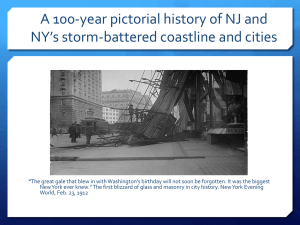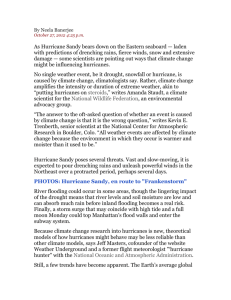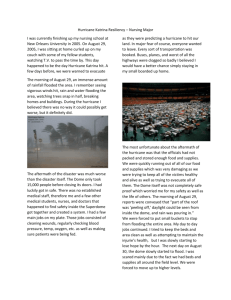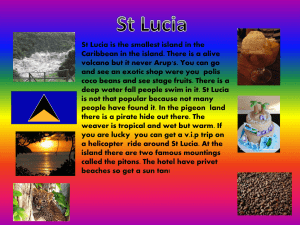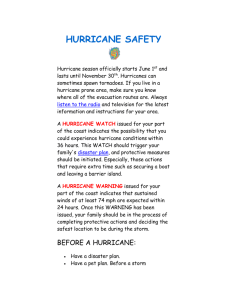Hurricane Notes
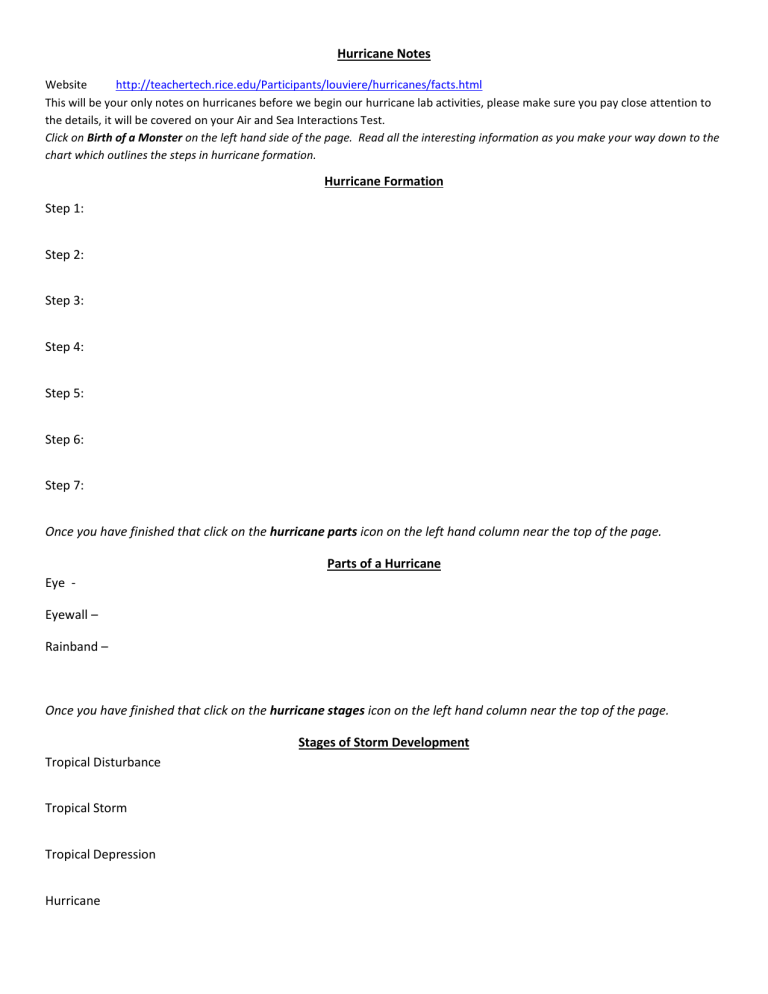
Hurricane Notes
Website http://teachertech.rice.edu/Participants/louviere/hurricanes/facts.html
This will be your only notes on hurricanes before we begin our hurricane lab activities, please make sure you pay close attention to the details, it will be covered on your Air and Sea Interactions Test.
Click on Birth of a Monster on the left hand side of the page. Read all the interesting information as you make your way down to the chart which outlines the steps in hurricane formation.
Hurricane Formation
Step 1:
Step 2:
Step 3:
Step 4:
Step 5:
Step 6:
Step 7:
Once you have finished that click on the hurricane parts icon on the left hand column near the top of the page.
Parts of a Hurricane
Eye -
Eyewall –
Rainband –
Once you have finished that click on the hurricane stages icon on the left hand column near the top of the page.
Stages of Storm Development
Tropical Disturbance
Tropical Storm
Tropical Depression
Hurricane
Once you have finished that click on the hurricane categories icon on the left hand column near the top of the page.
Tracking System
Who created the system used today to track hurricane development?
Complete the following chart:
Category Wind Speed Storm Surge Damage
What category must a hurricane fall into in order to be considered a major hurricane?
Example
Once you have finished that click on the effects of a hurricane icon on the left hand column near the top of the page.
In which quadrant are the maximum effects felt?
Effects of a Hurricane
What is storm surge?
What are the two factors effecting storm surge?
How much rainfall usually accompanies a hurricane?
When does the most rain fall?
Where is this rainfall the deadliest?
What other natural disaster often accompanies hurricanes?
How many hurricanes produce tornados?
What are rip tides?
Once you have finished that click on the fast facts icon on the left hand column near the top of the page.
Fast Facts - Hurricane Trivia
Hurricanes often cause between _______________ of rainfall in a short period. In 1921 a hurricane deposited
__________________ on Texas in a single day.
Every second a hurricane releases as much energy as the explosion of an _____________________.
The energy released by a hurricane would, if converted into electricity, power the United States for _________.
The heat energy released by a hurricane in one day can equal the energy released by the __________ of four
hundred 20 mega-ton hydrogen bombs.
On the average ___________ Atlantic hurricanes occur per year.
Each second some ______________________ of air are circulated in, up, and out of the hurricane.
The hurricane season in North Atlantic is ___________________. Over the _________________________ the tropical cyclone season is never quite over.
______________________ is the most active of the hurricane season's months.
Different countries have different names like the Philippines is ______________, Indian Ocean is
______________, Pacific is __________________, and Australia is _________________.
The number 1 killer storm in recorded history struck __________________ in 1737, with 300,000 officially dead.
A hurricane can be up to ____________ miles in diameter and can reach ___________________ miles into the air.
Most hurricanes happen in __________________________________________________.
Nearly all deaths associated hurricanes are caused by the _____________________ which is the dome of water that forms near the eye just before the storm hits land. In 1969, Hurricane Camille generated a ________ foot storm surge.
Many hurricanes produce ___________________________________.
Storms are given ___________________________ when they become tropical storms.
Hurricane ______________________, which hit South Florida and Louisiana in 1992, was the most costly
hurricane ever, with an estimated damage of at least $30 billion.
The average life of a hurricane is __________________ days. The hurricane is most destructive during its first
____________ hours onshore. A typical eye measures _______________ miles (32 kilometers) across.
The record for the most hurricanes in a season is 12, set in _____________. Though hurricanes can occur at any time, the official hurricane season in the Atlantic falls between _____________________. An average year has
________________________ hurricanes, which occur mostly in August, September, and October.
Often the ________________________ side of a hurricane causes the worst storm surge, winds, and tornadoes.
The word "hurricane" comes from Huracan, the god ______________________________________once
worshiped by the Maya people of Central America.
The deadliest hurricane in U.S. history hit ______________________, TX in 1900. The
"_____________________________" as it was called, killed six thousand people, mostly from drowning, when an _________________________ storm surge inundated Galveston Island.
The Atlantic Ocean thermohaline conveyor belt has a large impact on if each season expects lots of hurricanes or not.
What is the thermohaline?
What about it determines the # of hurricanes?
Across
3. A large mound of water thrusts onto the shore by the hurricane as it approaches the land
9. The area immediately surrounding the eye that consists of cooler air and greater pressure than the eye
10. The storm develops into a disorganized system with a closed circulation; wind speeds are between 25 and 38 mph
14. Counterclockwise circulation of clouds and winds, and the wind speed is between 39 and 73 mph
16. Calm column of rapidly rising air at the center of a hurricane
17. A storm with a distinct counter-clockwise rotation and wind speeds of at least 74 mph
18. An organization that monitors weather and issues public advisories to warn people of these conditions
Down
1. Occurs from June 1 through November 30
2. An advisory issued by the National Weather Service when a hurricane threatens a coastal area within 24-36 hours
3. The scale used to categorize a hurricane by its wind speed and barometric pressure
4. Hurricane with wind speeds of 111-130 mph
5. An advisory issued by the National Weather Service when a hurricane is expected to make landfall within 24 hours
6. The Texas city where the deadliest hurricane occurred
7. Hurricane with wind speeds of 96-110 mph
8. Hurricane with wind speeds of 74-95 mph
10. A moving area of thunderstorms in the tropics
11. The first developmental stage of a hurricane, where there is a lack of circulation, the winds are blowing in all directions, and the wind speed is < 25 mph
12. The major source of energy for a hurricane
13. Hurricane with wind speeds >155 mph
15. Hurricane with wind speeds of 131-155

